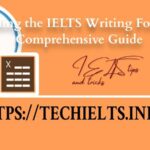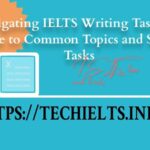Check out our blog to learn new words and get ready for IELTS Writing Task 1! In this blog post, we’ll give you useful vocabulary-building tips and ideas for this important school writing task. To do well on IELTS Writing Task 1, you need to work on your words a lot. This is because the task shows how well you can share information based on pictures. At the end of this blog post, you will know some useful vocabulary words, time sentences, and word groups. These will give you the courage and skills to do this job well. Let’s start right away!

Understanding the IELTS Writing Task 1
To understand how language affects IELTS Writing Task 1, you need to know what the task is about and how it is structured. To see how well candidates can use graphs, charts, tables, and diagrams to show, explain, and summarise facts, they must complete IELTS Writing Task 1. This job has two parts: academic and general training. How do you write for school on the Academic test? The General Training test is more about writing for everyday life. Each candidate has 20 minutes to write at least 150 words. This is true no matter what kind of test they are taking.
When someone takes a writing test, their score is based on a lot of things, like how well they did on the task, how well their writing moves, and how easy and broad their vocabulary is. Word choice is very important because it affects your lexical resource score, which is based on how many and different words you use. To get a good band score on this job, it’s important to build up your vocabulary.
What is IELTS Writing Task 1?
When students do IELTS Writing Task 1, they have to look at and explain graphs, tables, maps, line graphs, bar graphs and pie charts. For this job, candidates must use the given data to write a summary of the most important features, trends, and comparisons.
Different types of graphs might show different things. One type might show the number of people who joined a gym over time. Another type might show the number of sales of different goods in a certain year. If you have a family budget, a pie chart could show how the costs are split up. For school, a table could show how each student did in each subject. As well as flow charts and process models, candidates may sometimes be asked to explain a system or process step by step.
To do well on IELTS Writing Task 1, you need to carefully look at the visual data, find important patterns or trends, and then show the data in a way that is clear and easy to understand. You need to know a lot of words and choose the right ones to accurately express the main features, trends, and comparisons in the writing job.
Why is vocabulary important in IELTS Writing Task 1?
Word choice is very important in IELTS Writing Task 1 for a number of important reasons. Your lexical supply, or the number and quality of the words you use, is the first thing this job looks at. You can get a higher band score if you use a lot of different words in your work. This shows that you know how to use English well.
Also, one of the most important things judges look at when deciding how good your writing is is how well you can summarise and explain what they tell you. You can clearly explain the key points, trends, and comparisons if you use the right words. This will meet the needs of the job.
Using words that are special to the job not only makes your writing more accurate and in-depth, but it also makes it easier to understand and follow. Connecting your ideas in a way that makes sense makes it easier for the reader to understand what you’re trying to say. When your thoughts make sense, they are coherent. When you use good vocabulary in your writing, it flows better, which makes your answer better and move better too.
If you want to get a good score on IELTS Writing job 1, you should use a lot of different words and show that you can do the job. Also, your work should make sense and flow well. In what comes next, we’ll look at some key words and phrases that will help you write better for this job.
Key Vocabulary for IELTS Writing Task 1
Use of Key Vocabulary for IELTS Writing Task 1 can make or break your score on the test. To talk about trends, learn words like “highest point” and “lowest point.” This is especially important when talking about data shown in a bar graph or a flow chart. These terms are very important to know for both the academic part of the IELTS test and for everyday use. It is also important to use the right tense and give approximations when giving accurate numbers in order to communicate facts clearly.
Descriptive Adverbs and Adjectives
It is very important to use adverbs and words like “gradually,” “sharply,” “steadily,” “significantly,” “steeply,” “moderately,” “rapidly,” and “slightly” to describe trends in IELTS writing task 1. This will help you make your trend statements more detailed and logical. Words are very important on the IELTS test, and if you use them correctly, you can get a high band score on both the academic and general training parts. These descriptive words and adverbs not only help you connect important details better, but they also get the job done. Using these words in a way that sounds natural and makes sense is the best way to make sure that writing job 1 runs well.
Useful ways to describe time
When writing about time for the IELTS, it’s important to use time words like “over a period of time,” “between specific years,” and “throughout the period.” These words make the time frame clear and help explain how time ties work in a way that makes sense. It’s important to use the right time phrases to make sure that writing job 1 makes sense and to show trends clearly. On the IELTS writing test, the tester looks at the different time expressions and stresses how important they are for making sure the writing flows.
Sorting IELTS Writing Task 1 Words into Groups
Knowing the different kinds of words used in IELTS job 1 Writing is very important. Putting words together in groups helps you understand and think about what the question is asking. Nouns, verbs, adjectives, and adverbs are the most common types of words used to show facts or identify trends. For the IELTS test, you also need to know the exact words for different kinds of graphs, flow charts, and pie charts so that the information is easy to understand.
Being able to use the right words to talk about heights, distances, and the number of people in a room can also greatly improve your ability to speak clearly. You should also know that the Academic and General Training IELTS tests might have different language requirements, so people who want to take them should make sure they are ready for both.
How to Talk About Growing Trends
When you talk about growing trends in IELTS writing task 1, you should use a variety of words and phrases that mean “grow” or “rise.” To finish the job, you need to use the right verbs and words that show trends going up. Using a variety of words to talk about trends that are growing is an important part of finishing writing job 1. Many thanks for the good vocabulary resource score. The use of adverbs and adjectives to show upward trends is clear and consistent. With this wide range of words, candidates can show that they know how to use graphs and flow charts, which are pictures that show upward trends.
What to Say When Trends Are Going Down
When talking about trends that go down, it’s important to use words and phrases that show decrease or drop. When writing job 1, it’s very important to pick the verbs and words that show decreasing figures with care. It helps with cohesion and consistency to use words that describe trends that are going down. It also helps you meet your job goals. You can also get a big boost to your band scores if you use this type of language well. It has a direct effect on your vocabulary resource score. To get good grades on writing job 1, use adverbs and phrases that show trends of going down together.
Enhancing Descriptions in IELTS Writing Task 1.
It is important to use a lot of different words when you are writing Task 1 for the IELTS. It’s possible to improve the writing by including details and close predictions like numbers, percentages, and comparisons. To be clear, you need to use the right tense and make sure that the changes between lines go smoothly. Using the high and low points of a bar graph is just as important as using a flow chart to understand how a process works. You should also think about who the description is for, since words for a general training test might be different from those for an academic test. You can get even better descriptions and do better on the IELTS test if you use these things along with a video lesson, tips from pros like Liz from “ieltsliz.com,” or tools from the British Council.
How to Tell the Difference Between Amount and Rate
To make sure you get your point across, know the difference between “rate” and “amount” when you talk about data. “Amount” refers to the whole number or amount of something, while “rate” refers to how fast or often something happens, like the rate of change. Making this difference clear keeps people from getting confused and makes it easy to share different pieces of information. When talking about exact amounts or totals, “amount” is the right word. When talking about changes over time, or changes in patterns or trends, “rate” is the right word. Make the difference between “rate” and “amount” clear. This keeps the story on track and helps the reader understand the information better.
How the examiners rate your vocabulary on IELTS Writing Task 1
They check your knowledge by seeing how many and what kind of words you use in IELTS Writing Task 1. In order to get their point across, they want someone with a large vocabulary that uses both common and unusual words that are relevant to the material. The right way to use NLP techniques, like citing words and sentences, will help you get a better grade. This will help your work flow better and make more sense. Also, it’s very important to use the right tense when showing proper information, especially when talking about how data changes over time. Testers also look at how well you explain comparisons and approximations. This shows how well you use words and explain important details.
Why it’s important to write things down clearly
People must be able to communicate well in order to understand and pass on ideas properly. People will be more likely to understand and be interested in what you have to say if you speak clearly. To correctly understand and interpret what is written, it is important to use clear wording that removes any confusion that might get in the way. Making your ideas clearer not only makes your writing more logical, but it also makes sure that the information moves more smoothly, which helps the reader understand and be interested in what you’re writing.
How important it is to spell and language check your work
When you write something, it should look more professional, trustworthy, and easy to read if you use correct writing. When you use the right collocations, the language flows better and is easier to understand. When used correctly and regularly, collocations make the writing flow better, which helps the reader understand it better in the end. To show how skilled and accurate the writer is with language, exact collocations also make the vocabulary and general linguistic accuracy of the written work better.
The reason you need topic-specific words
Not only will your writing be clearer and more accurate if you use subject-specific language, but your ideas will also make more sense and move better. Using topic-related words makes the writing better and more useful, and it also shows that you know a lot about the subject. Using topic-specific words also makes the writing clearer, more in-depth, and more relevant, which shows that you know a lot about the subject. A lot of different people can understand difficult ideas with this method, and the information is always correct no matter how many people read it.
Effective Practice Strategies for IELTS Writing Task 1 Vocabulary
You need to do regular vocabulary drills and tasks to build up your vocabulary for the IELTS writing task. Using different words in the right places not only makes the writing move better and be clearer, but it also makes it more precise. You can learn a lot more words if you do activities that help you build words, like phrase drills and word association exercises. To get ready, you should look through themed word lists and do specific word practice for different types of writing jobs. Tasks that use mnemonics, context-based learning, and language are all great ways to make sure you remember and use words better, which will help you ace the IELTS test.
How does going over things over and over again help you learn new words?
By practicing often, you gain more information and make it bigger. Going over things over and over again can help you learn a lot of new words and lines. You can improve your language skills and word choice by learning words over and over again.
Conclusion
To sum up, you need to learn new words if you want to do well on IELTS Writing Task 1. If you know what the job requires and use the right words, you can talk about trends, check your comparisons, and go into great depth. Trend-based word groups are useful, and using adverbs, adjectives, and time phrases to describe things will improve your writing. The people who grade your work also look at how well you communicate, spell, and use words that are specific to the subject. It’s very important to keep practicing if you want to learn more. You should regularly do things like reading, listening to podcasts, and writing. Here are some study tips that will help you get better at English and do better on IELTS Writing Task 1.






